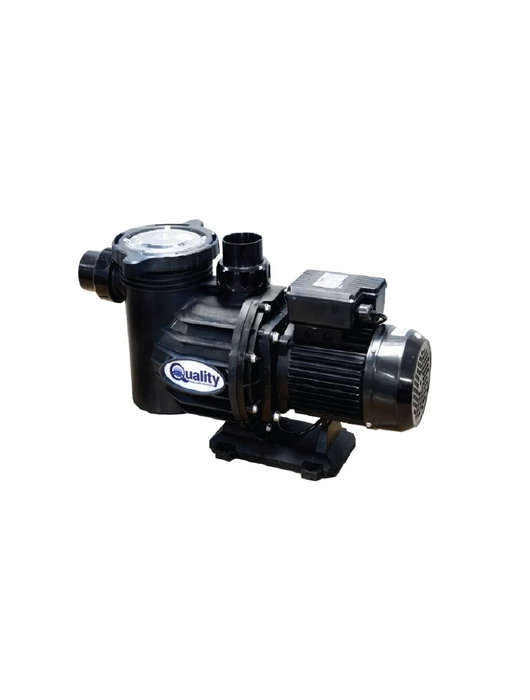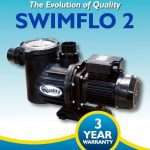





POOL PUMP AND MOTOR QUALITY SWIMFLO 2 1.1KW
Check my rate
| Main centres: | 1-3 business days |
| Regional areas: | 3-4 business days |
| Remote areas: | 3-5 business days |






| Main centres: | 1-3 business days |
| Regional areas: | 3-4 business days |
| Remote areas: | 3-5 business days |
Experience the future of pool pump technology with the new generation of the QUALITY SWIMFLO 2. Packed with advanced features, this swimming pool pump promises enhanced performance, unparalleled reliability, and energy efficiency.
Dive into an unparalleled pool experience with the SWIMFLO 2. Continuing its legacy of high-efficiency motors, this upgraded version brings more to the table. Its core boasts a composite stainless steel shaft accompanied by a 3/4" ceramic shaft seal. To amplify user convenience, the pump introduces a novel low-profile, twist-and-lock lid design, ensuring hassle-free access and secure sealing.
Choosing the right pump is critical. Designed for pools as vast as 90,000 litres, the Quality SWIMFLO 2 1.1kW Pump works seamlessly with a 4-bag sand filter. This self-priming pump offers versatility in installation whether you prefer it above or below the ground. Ensure a flat, flood-free zone for optimum performance. Professional installation by an electrician is recommended for safety and best outcomes.
Get optimal filtration with the Quality 4-Bag Sand Filter or Eartheco 4 Bag Sand Filter perfectly matched to the SFP11's power.
Need a step down in size? Try the Quality 0.75kW Swimflo 2 Pump (SFP75) for medium-sized pools.
Don't forget to stock up on Pump Accessories for maintenance and installation ease.
We recommend that the pump is installed by a qualified pool professional or electrician.
A good installation of your pool pump will result in many years of trouble-free operation. Careful attention must be paid to the following:
1. Piping: The suction and discharge pipes must not be smaller in diameter than the pump connection i.e., Suction pipe diameter 50mm minimum (recommended 63mm), outlet pipe diameter 50mm minimum. Suitable unions should be used on the pump connections or placed in the lines adjacent to the pump connections in case the pump needs to be removed at any time. Do not support the pipework on the pump or vice versa. Make sure all pipe connections are completely water/airtight by using a suitable pipe jointing compound. Keep suction pipe as short as possible and only use pipes that are sufficiently rated to work at a minimum of 4 bar pressure. The suction line should enter the pump straight and horizontally for a length of at least 4 x the diameter of the pipe. The pump is a self-priming pump, which can be installed above or below water level, if you choose to go below, be sure to connect a control valve on your suction pipe between the pool weir/skimmer and the pump, which will prevent your pump being flooded when you open the lid to clean the pump leaf basket. Do not over tighten fittings into the inlet and outlet of the pump. Position pump on a flat level surface not exposed to flooding, as the pump motor is not waterproof.
2. Pump Positioning: (Important for motor cooling): We recommend that the pump be positioned at a level of no more than ± 300mm above your pool water level. Again, we stress the fact to keep the suction line as short as possible. A minimum clearance of 150mm must be allowed behind the motor fan cowling to the nearest obstruction to ensure proper air ventilation and easy access for servicing. The pump house/box must also have provision for adequate drainage facilities.
3. Ventilation: As the electric motor is fan cooled, sufficient ventilation must be allowed at all times during operation. Failure to do this will cause overheating resulting in premature bearing failure and/or motor burnout. If your pump house/box does not have ventilation holes the lid or door should be left open during operation of the pump.
4. Drainage: Flooding of the electric motor is the most common cause of motor failure. It is essential that adequate drainage be provided in the pump house/box. If the motor fails as a result of flooding, then there is no warranty whatsoever irrespective of how the water penetrated the motor. The pump must be protected from rain and flooding.
5. Electric Connections: These must be carried out by suitably qualified people only. Do not change the motor position as it is provided with a drain hole at the bottom to drain off any water which may leak past the mechanical shaft seal. A cable gland must be fitted to the terminal box. NOTE: The length of cable supplied with the pump is for testing only and should be replaced with suitably rated cable. Minimum specification 60245IEC66 (HO7RN-F).
6. Rotation: Before checking the rotation, drain the pump leaf trap of water. The correct rotation is clockwise when viewed from the motor end. Pumps with 220-volt single phase motors are wired at the manufacturer for the correct rotation.
How to keep your pool pump in good running condition
1. Clean the leaf trap in the pump and pool weir regularly.
2. Do not allow dust to accumulate on the motor as this affects the cooling process.
3 Do not leave foreign objects lying on the motor.
4 Change the rubber 0-Ring in the lid at 1-year intervals to maintain a good seal. The face on the leaf trap where the 0-Ring sits must be kept clean and smooth.
6. DO NOT RUN THE PUMP DRY or under closed valve conditions for extended periods.
7...